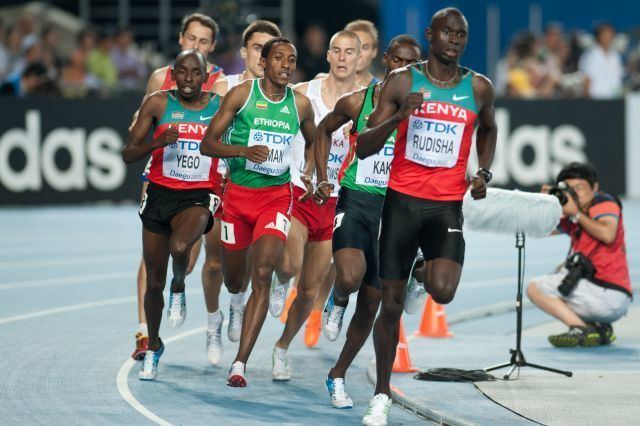 | ||
World Jarmila Kratochvílová 1:53.28 (1983) Olympic Nadezhda Olizarenko 1:53.43 (1980) | ||
The 800 metres, or 800 meters (US spelling), is a common track running event. It is the shortest common middle-distance running event. The 800 metres is run over two laps of the track (400 metre track) and has been an Olympic event since the first games in 1896. During indoor track season the event is usually run on a 200-metre track, therefore requiring four laps.
Contents
The event was derived from the imperial measurement of a half a mile (880 yards), a traditional English racing distance. Imperial racing distances were common in the United States. American high schools (in the name of the NFHS) were the last to convert to metric distances in 1980, following the NCAA's conversion in 1976. Countries associated to the English system converted to metric distances after the 1966 Commonwealth Games. 800 m is 4.67 m less than half a mile.
The event combines aerobic endurance with anaerobic conditioning and sprint speed. Both the aerobic and anaerobic systems are being taxed to a high extent, thus the 800 metre athlete is required to combine training between both systems.
Runners in this event are often fast enough to compete in the 400 metres and/or the 4 × 400 metres relay but only Alberto Juantorena and Jarmila Kratochvílová have won major international titles at 400 m and 800 m. If they are so inclined, 400 m runners are usually encouraged to run the 200 metres while 800 m runners are encouraged to run the 1500 metres.
Race tactics
The 800 m event is also known for its tactical racing techniques. Because the 800 m event is the shortest event that has all the runners converge on lane one, positioning on the cut-in is critical to the outcome of the race. It is commonly believed that getting the first or second position early in the race is advantageous as these positions are not usually caught up in the pack. Olympic champions Dave Wottle, Yuriy Borzakovskiy and others have defied that logic by running a more evenly paced race, lagging behind the pack and kicking past the slowing early leaders. Often the winner of 800 m races at high levels are not determined by the strongest runner but instead by the athlete with the best positioning near the end of the race. This can lead to the most exciting aspect of the 800 m which is its high probability of an upset.
Two common tactics for the 800 meters are running a negative split or a positive split between laps. The positive split is widely considered to be the more effective strategy, but on occasion experienced runners have been known to use a negative split to their advantage. A positive split is achieved by running the first lap faster than the second lap, and a negative split is achieved by the opposite, running the second lap faster than the first. The current world record holder, David Rudisha, runs using a positive split strategy. In his 2012 Olympic race, he ran his first lap in 49.28 seconds and his second lap in 51.63 seconds. Theoretically, an even split is the most effective strategy, but it is nearly impossible to achieve due to the race's length.
Men
As of August 2016
Women
As of August 2016.
Juniors
World junior records (19 and under) are held by Nijel Amos (1:41.73, London, 9 August 2012) and Pamela Jelimo (1:54.01, Zürich, 29 August 2008). Both marks coincidentally rank them as the third fastest ever.
